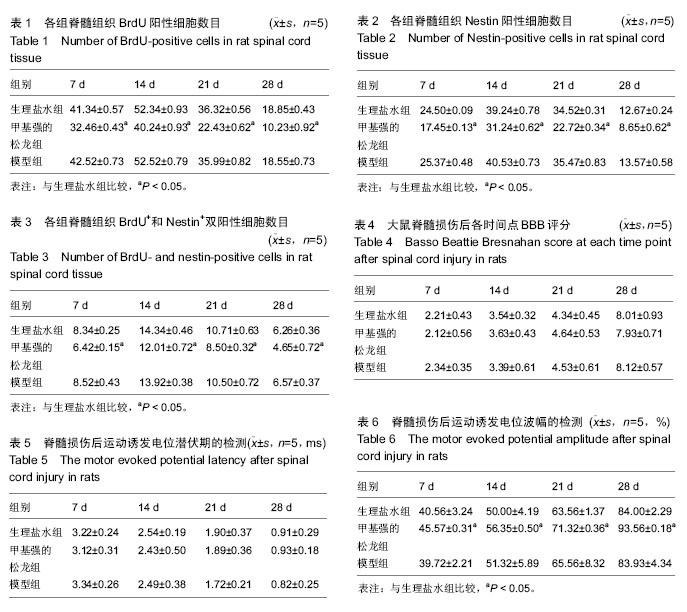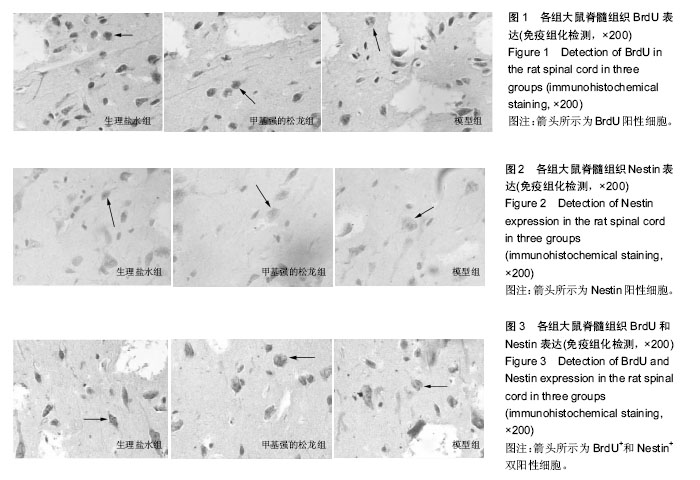| [1] Cirillo G, Colangelo AM, De Luca C, et al. Modulation of Matrix Metalloproteinases Activity in the Ventral Horn of the Spinal Cord Re-stores Neuroglial Synaptic Homeostasis and Neurotrophic Support following Peripheral Nerve Injury. PLoS One. 2016;11(3):e0152750.
[2] Trofimenko V, Hotaling JM. Fertility treatment in spinal cord injury and other neurologic disease. Transl Androl Urol. 2016;5(1):102-116.
[3] Lemmon VP, Abeyruwan S, Visser U,Jet al. Facilitating transparency in spinal cord injury studies using data standards and ontologies. Neural Regen Res.2014; 9(1): 6-7.
[4] Güzelküçük Ü, Demir Y, Kesikburun S, et al. Spinal cord injury resulting from gunshot wounds: a comparative study with non-gunshot causes. Spinal Cord. 2016 Mar 1. [Epub ahead of print]
[5] Schwab JM, Chiang N, Arita M, et al. Resolvin E1 and protectin D1 activate inflammation-resolution programmes. Nature. 2007;447(7146):869-874.
[6] Forner S, Martini AC, de Andrade EL, et al. Neuropathic pain induced by spinal cord injury: Role of endothelin ETA and ETB receptors. Neurosci Lett. 2016;617:14-21.
[7] Yeng CH, Chen PJ, Chang HK, et al. Attenuating spinal cord injury by conditioned medium from human umbilical cord blood-derived CD34? cells in rats. Taiwan J Obstet Gynecol. 2016;55(1):85-93.
[8] Dong Y, Miao L, Hei L, et al. Neuroprotective effects and impact on caspase-12 expression of tauroursodeoxycholic acid after acute spinal cord injury in rats. Int J Clin Exp Pathol. 2015;8(12): 15871-15878.
[9] Knoller N, Auerbach G, Fulga V, et al. Clinical experience using incubated autologous macrophages as a treatment for complete spinal cord injury: phase I study results. J Neurosurg Spine. 2005;3(3):173-181.
[10] Dong YZ,Yang LB,Yang L,et al.Transplantation of neurotrophin-3-transfected bone marrow mesenchymal stem cells for the repair of spinal cord injury. Neural Regen Res.2014;9(16): 1520-1524.
[11] Erlandsson A, Lin CH, Yu F, et al. Immunosuppression promotes endogenous neural stem and progenitor cell migration and tissue regeneration after ischemic injury. Exp Neurol. 2011;230(1):48-57.
[12] Bartholdi D, Schwab ME. Expression of pro-inflammatory cytokine and chemokine mRNA upon experimental spinal cord injury in mouse: an in situ hybridization study. Eur J Neurosci. 1997;9(7):1422- 1438.
[13] Mao D, Yao X, Feng G, et al. Skin-derived precursor cells promote angiogenesis and stimulate proliferation of endogenous neural stem cells after cerebral infarction. Biomed Res Int. 2015;2015:945846.
[14] Thored P, Arvidsson A, Cacci E, et al. Persistent production of neurons from adult brain stem cells during recovery after stroke. Stem Cells. 2006;24(3):739-747.
[15] Horky LL, Galimi F, Gage FH, et al. Fate of endogenous stem/progenitor cells following spinal cord injury. J Comp Neurol. 2006;498(4):525-538.
[16] Goldman S. Stem and progenitor cell-based therapy of the human central nervous system. Nat Biotechnol. 2005;23(7):862-871.
[17] Hohlfeld R, Kerschensteiner M, Meinl E. Dual role of inflammation in CNS disease. Neurology. 2007;68 (22 Suppl 3):S58-63.
[18] Yacoubian S, Serhan CN. New endogenous anti-inflammatory and proresolving lipid mediators: implications for rheumatic diseases. Nat Clin Pract Rheumatol. 2007;3(10):570-579.
[19] de Araújo RF Jr, Reinaldo MP, Brito GA, et al. Olmesartan decreased levels of IL-1β and TNF-α, down-regulated MMP-2, MMP-9, COX-2, RANK/RANKL and up-regulated SOCs-1 in an intestinal mucositis model. PLoS One. 2014;9(12):e114923.
[20] Sakthivel KM, Guruvayoorappan C. Acacia ferruginea inhibits tumor progression by regulating inflammatory mediators-(TNF-a, iNOS, COX-2, IL-1β, IL-6, IFN-γ, IL-2, GM-CSF) and pro-angiogenic growth factor- VEGF. Asian Pac J Cancer Prev. 2013;14(6):3909-3919.
[21] Aharoni R, Saada R, Eilam R, et al. Oral treatment with laquinimod augments regulatory T-cells and brain-derived neurotrophic factor expression and reduces injury in the CNS of mice with experimental autoimmune encephalomyelitis. J Neuroimmunol. 2012;251(1-2):14-24.
[22] Stirling DP, Liu S, Kubes P, et al. Depletion of Ly6G/Gr-1 leukocytes after spinal cord injury in mice alters wound healing and worsens neurological outcome. J Neurosci. 2009;29(3):753-764.
[23] Kawasaki Y, Zhang L, Cheng JK, et al. Cytokine mechanisms of central sensitization: distinct and overlapping role of interleukin-1beta, interleukin-6, and tumor necrosis factor-alpha in regulating synaptic and neuronal activity in the superficial spinal cord. J Neurosci. 2008;28(20):5189-5194.
[24] He X, Shu J, Xu L, et al. Inhibitory effect of Astragalus polysaccharides on lipopolysaccharide-induced TNF-a and IL-1β production in THP-1 cells. Molecules. 2012; 17(3):3155-3164.
[25] Boato F, Rosenberger K, Nelissen S, et al. Absence of IL-1β positively affects neurological outcome, lesion development and axonal plasticity after spinal cord injury. J Neuroinflammation. 2013;10:6.
[26] Hassanshahi G, Amin M, Shunmugavel A, et al. Temporal expression profile of CXC chemokines in serum of patients with spinal cord injury. Neurochem Int. 2013;63(5):363-367.
[27] De Filippis L, Südhof TC, Pang ZP. Harness the power of endogenous neural stem cells by biomaterials to treat spinal cord injury. Sci China Life Sci. 2015;58(11): 1167-1168.
[28] Lytle JM, Wrathall JR. Glial cell loss, proliferation and replacement in the contused murine spinal cord. Eur J Neurosci. 2007;25(6):1711-1724.
[29] Mladinic M, Nistri A. Dynamic expression of ATF3 as a novel tool to study activation and migration of endogenous spinal stem cells and their role in neural repair. Neural Regen Res. 2015;10(5):713-714.
[30] Durak H, Atmaca S, Karayi?it MÖ, et al. Effect of Mitomycin C on bFGF, TGF-β1, KGF-1 Expressions after Myringotomy: An Animal Study. J Int Adv Otol. 2015;11(3):188-191.
[31] Hall ED. Methylprednisolone for the Treatment of Patients with Acute Spinal Cord Injuries: A Propensity Score-Matched Cohort Study from a Canadian Multi-Center Spinal Cord Injury Registry. J Neurotrauma. 2016;33(10):972-974.
[32] Wang W, Wang P, Li S, et al. Methylprednisolone inhibits the proliferation and affects the differentiation of rat spinal cord-derived neural progenitor cells cultured in low oxygen conditions by inhibiting HIF-1α and Hes1 in vitro. Int J Mol Med. 2014;34(3):788-795.
[33] Jing YH, Hou YP, Song YF, et al. Methylprednisolone improves the survival of new neurons following transient cerebral ischemia in rats.Acta Neurobiol Exp (Wars). 2012;72(3):240-252. |
.jpg)


.jpg)